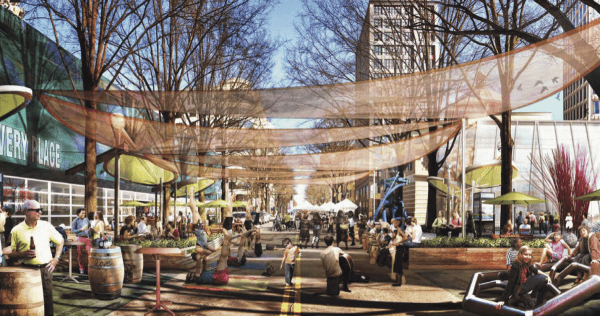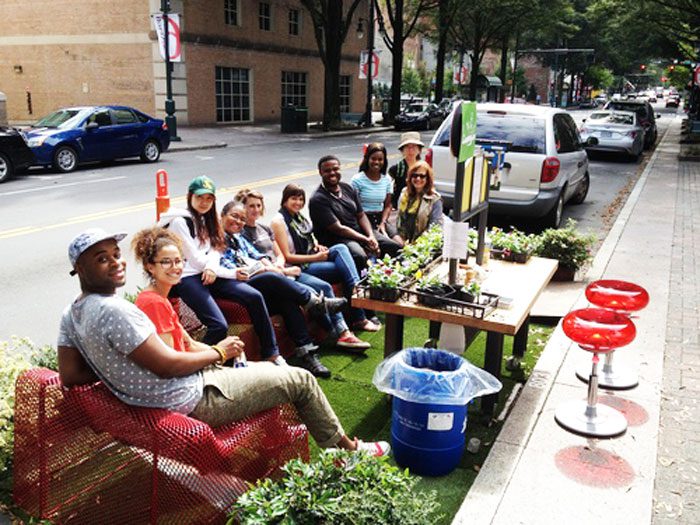What does coronavirus mean for the future of urbanism in Charlotte?

Monday night’s rezoning meeting felt like most Charlotte City Council sessions from previous years, despite the mayor and staff sitting six feet apart and developers battling audio and video glitches in the remote setup.
Council members heard proposals about denser developments in suburban enclaves. The biggest was a plan to transform Ballantyne Corporate Park from a low-density outpost ruled by the automobile into a walkable, transit-connected hub of urbanism drawing thousands of hip, young people to work and play in apartments, restaurants and office buildings nestled closely together.
Another month in the ongoing metamorphosis of a “New South” city from its postwar, auto-centric roots into something more cohesive than a jumble of single-family subdivisions, malls and office parks.
But even though developers are moving forward with most of their previously announced plans and cranes are still filling in the blank spaces on our city’s skyline with new towers, questions are swirling about what the era of COVID-19 means for the much-touted urban revival.
Apart from the side effects from a catastrophic economic collapse, will cities lose their appeal in a world where the things that make them special, from transit to theaters to sidewalk festivals, are suddenly shot through with a tinge of danger? And will Sunbelt cities like Charlotte see a reversal of their recent turn towards more urbanization?
“In the short-term, certainly, there will be greater emphasis on suburban living,” said David Walters, professor emeritus at UNC Charlotte and an architect. An advocate of better urban design in Charlotte for decades, he said discussions about coronavirus and urbanism have been dominating his thoughts in recent weeks.
Is density dead as an urban-regional selling point in a post-pandemic world?
— Chuck McShane (@chuckmcshane) April 18, 2020
“Like almost any urbanist, part of my brain, even if I’m not constantly thinking about it, seems to be ticking over, trying to debate these issues,” said Walters. “There are so many balls in the air, no one really knows.”
Like most urbanists, Walters said he’s optimistic that the long-term trends driving people to seek denser and more walkable lifestyles won’t be reversed. Cities will retain their appeal for many of the same reasons, such as people being fed up with ever-lengthening commutes and the atomization of suburbia.
But he said the long-term effects are unpredictable and could be significant. Will more people work from home and shun downtown offices? Will transit systems survive the devastating loss of ridership and revenue that’s putting a strain on already battered finances?
“Are we going to run scared of density?” asked Walters. “And if we do, what does that mean for public life in cities and pollution levels in the environment?”
[Read our coronavirus articles here]
Brook Muller, dean of the UNC Charlotte College of Arts + Architecture, said the crisis presents an opportunity to address needs that have been brought to the forefront. For example, people in dense areas have been realizing they need more open space, and innovative technologies that use open spaces to capture and treat stormwater could address that need while also bolstering urban infrastructure in an eco-friendly way.
“I think about this all the time,” said Muller. “Is this going to be a blip on our collective memory or a real opportunity for change?”

A group enjoys a parklet-for-a-day in front of Discovery Place on North Tryon Street. Photo: Courtesy Completeblocks.com
The pandemic has shone a light on the need for more public space: Charlotte, already ranked near the bottom of US cities for spending on and access to park space, has struggled with how to manage crowded parks as people seek escape from their houses.
Muller said he’s particularly worried about the impact to transit. Major systems like New York City’s are grappling with a shortfall that’s expected to reach billions of dollars as ridership evaporates, and could cut service or defer maintenance as a result. Charlotte is launching a major regional transit plan and a new east-west light rail line, which would cost billions.
“Is spatial distancing going to make us think that more efficient forms of transportation are dangerous? That really scares me,” said Muller. But Muller, who lives in South End and doesn’t own a car, said he’s also wondering about the implications of coronavirus for his own daily commute on a crowded train.
“I think about my daily Charlotte work routine, hopping on the Blue Line in the South End, and it’s packed,” said Muller. “What’s a safe way to ride? How am I going to get to school?”
Wells Fargo senior economist Mark Vitner told a Charlotte City Council committee on Monday that he doesn’t expect a long-term shift from denser, urban development to low-density suburbs. But he said he does expect some short-term impact, as the housing market dramatically slows and people hunker down until the advent of a vaccine.
“I don’t think we’re going to see behaviors change that much, but it is certainly going to slow that process down as we move through this crisis,” said Vitner. “When we move past this, there may be a little lingering fear of hey, what’s the next virus to come along?”
Architect Stephen Overcash, who’s been working in Charlotte for more than 40 years, expects more changes to the interior of buildings than to the urban fabric.
“The COVID-19 crisis will certainly change behaviors and architectural design. It will not significantly impact urbanism in Charlotte,” said Overcash. “With the tsunami of Millennials and Gen Z entering the workforce, urban planning principles of living, working and playing in dense proximity will remain popular and will continue to spur much of Charlotte’s urban infill growth.”
Overcash — who presented plans for an infill, urban hotel in SouthPark at Monday’s zoning meeting — said he does expect to see new materials, designs and a focus on things like air filtration that didn’t get as much attention before. Antimicrobial finishes, automatic sterilization and more touchless technology to minimize people’s contact with doors, knobs and buttons could all become expected features.
Another feature that could see changes: Open floor plan offices with lots of shared space. Vitner pointed out that companies have been shrinking the square footage per employee, and that trend could accelerate.
“Everybody’s gone to these open floorplates and had lots of shared spaces,” said Vitner. “We’ve closed down all these shared spaces. People are wondering gosh, are we going to see a reversal of that?”
And the pandemic could give life to long-simmering discussions about whether and how to close some of Charlotte’s streets to vehicles and open them up to pedestrians. Large cities across the US have done so, temporarily, to give pedestrians more space to socially distance than on crowded sidewalks and compensate for drastically reduced traffic.
Oakland made headlines by closing 74 miles — about a tenth of its total street network — to cars. Charlotte pedestrian and cycling advocates have been making the case for years that the city should close a few blocks of a central thoroughfare like Tryon Street or Camden Road to let pedestrians have more space.
This just makes sense and could be implemented on the most crowded sections of sidewalks, at least on weekends. https://t.co/9nbcjGKOEk
— Julie J Eiselt (@JulieEiselt) April 17, 2020
“In large part, crowding is what happens when we dedicate the vast majority of our public urban space to cars, with not nearly enough left over for people,” wrote city planner and urbanist Brent Toderian in a recent editorial. “Too little space on our sidewalks and streets, in our parks and public places, in our transit stations, subways and buses, and just about everywhere else.”
Whatever changes come, Walters said he’s sure of one thing: “The new normal won’t be normal at all.”